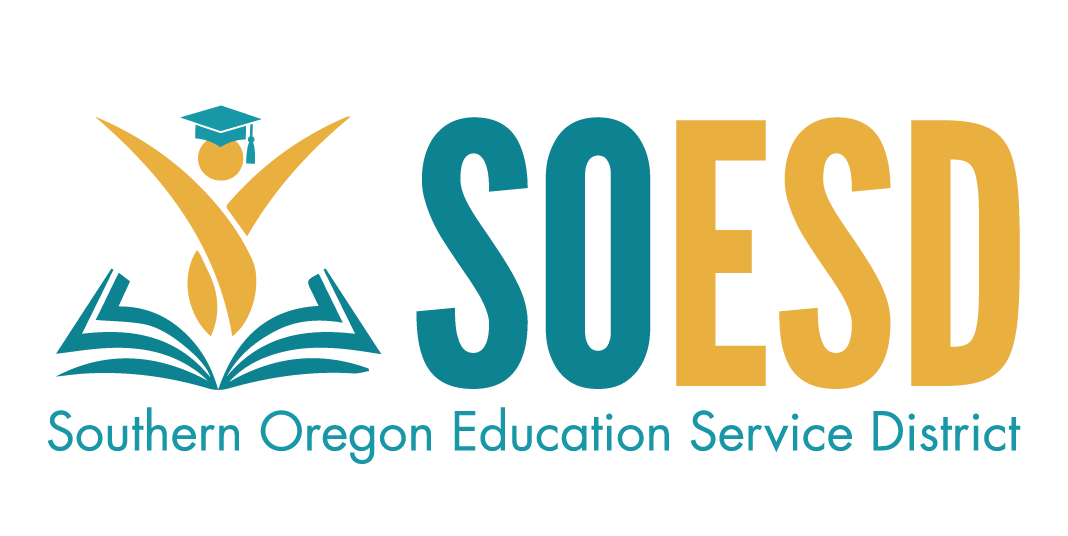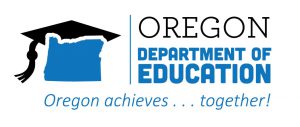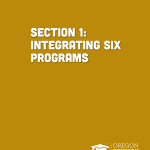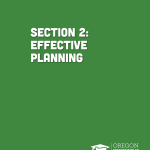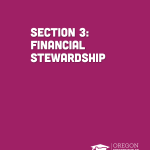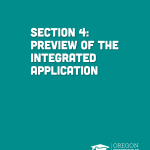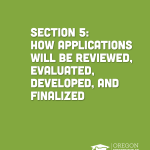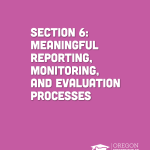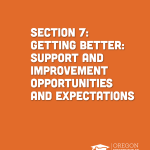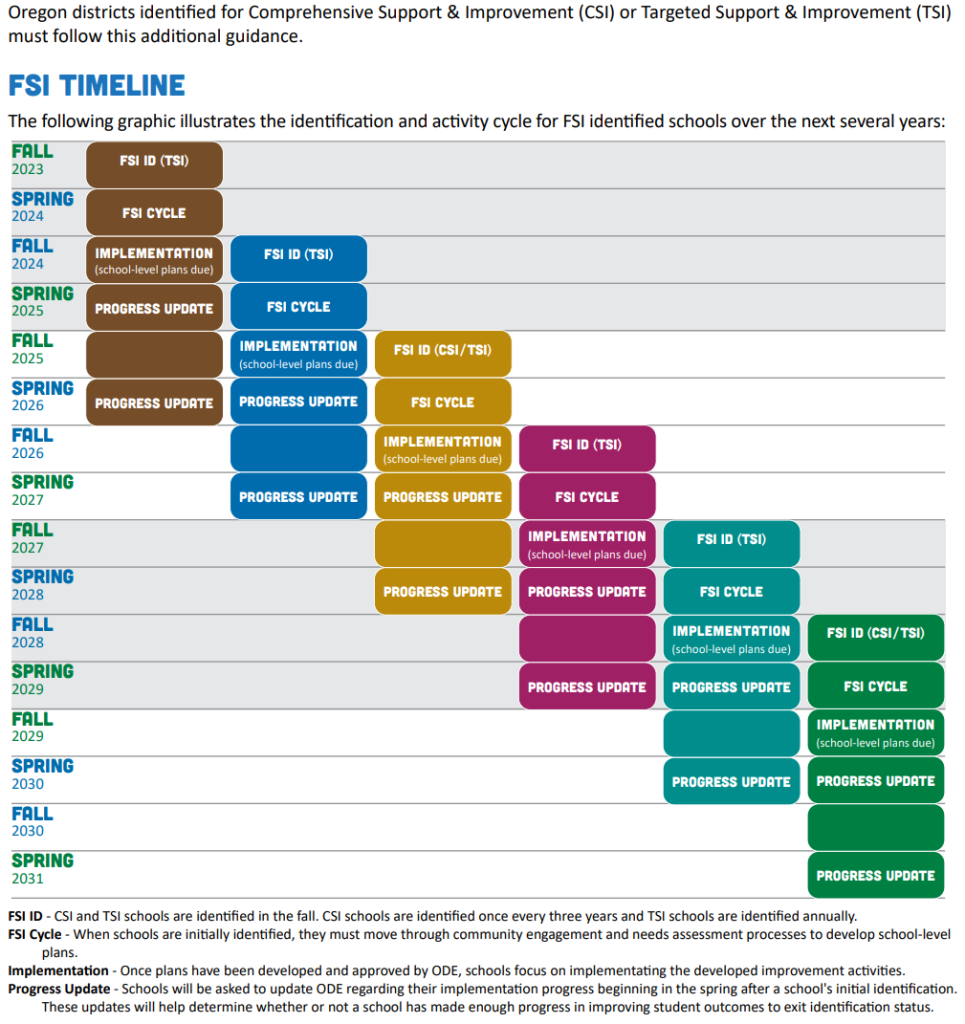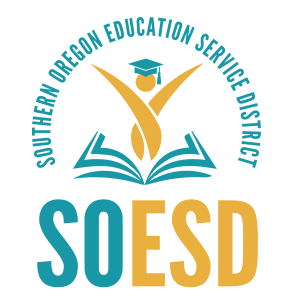What is the Student Success Act (SSA)?
The Student Success Act (SSA) was approved in 2019 as an investment in Oregon education.
When fully implemented, the Student Success Act is expected to invest $2 billion in Oregon education every two years; that’s a $1 billion investment in early learning and K-12 education each year. Of those funds, $200 million goes into the State School Fund and the remaining is distributed into three accounts: the Early Learning Account, the Student Investment Account and the Statewide Education Initiatives Account.
At the heart of the SSA is a commitment to improving access and opportunities for students who have been historically underserved in the education system.
The SSA has 3 components:
- Early Learning Account
- Student Investment Account (SIA; see below)
- Statewide Education Initiatives Account
SOESD is here to help.
There are a lot of components and monitoring requirements with SSA funding. We have a team ready to help your school/district with your SSA implementation.
Here are some highlights of what our team accomplished in the past biennium:
- SIA Implementation Specialists provided 3,405 hours of SIA mentoring support (click for detail)
- Teams provided professional learning, COVID-19 reopening support, and helped draft plans (click for detail)
- Specialists led webPD — online professional development courses– centered around mental and behavioral health (click for detail)
Contact
Tanya Frisendahl
Student Success Act Implementation Specialist Facilitator
Educational Services Team
tanya_frisendahl@soesd.k12.or.us
Morgan Cottle
Student Success Act Implementation Specialist Facilitator
High School Success/IPP Tribal Consultation
Educational Services Team
morgan_cottle@soesd.k12.or.us
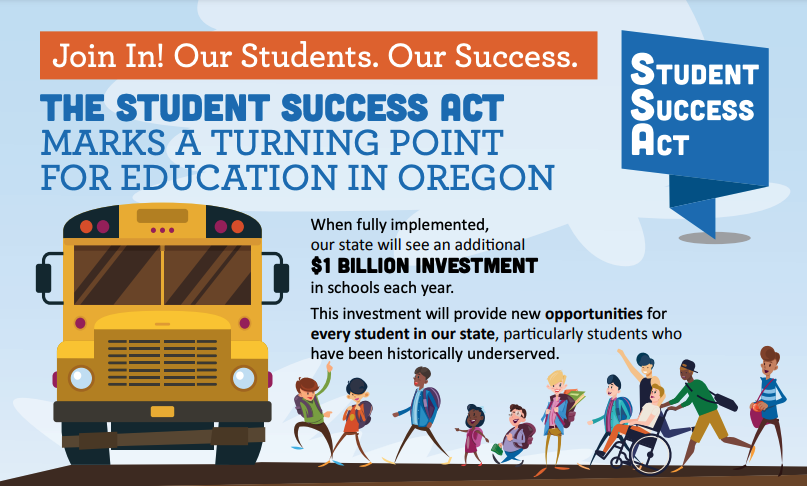
Integrated Guidance — used in planning the 2023-2025 & 2025-2027 bienniums.
The goal of the Integrated Guidance framework for success is to meet the core purposes of each program while trying to create a stronger framework from which we can mark progress, look for long-term impacts, and develop the learning approach to monitoring and evaluation that is a hallmark of high-performing educational systems.
2025-2027 Biennium Allocations are available (9/16/25)
Allocations for the above programs have been updated in the Integrated Application budgets within the Smartsheet WorkApp. Grantees can finalize these budgets during Quarter 1, which is due November 15, 2025.
- SIA, HSS, and Early Literacy allocations have now been updated in the WorkApp to reflect finalized amounts. Please refer to the allocation documents below for details:
- 25-27 Student Investment Account Allocations
- SIA Grant Agreements (23-25) are active until 9/30/25 and include the first quarter disbursement of 25-26 SIA funds. The first quarter disbursement is available in EGMS and grantees can claim 100% of current available funds. The remainder of the 25-27 allocation will be added when new grant agreements are executed.
- 25-27 High School Success Allocations
- HSS grant agreements will be sent for signature via Smartsheet to superintendents and business managers. You will receive an automated notification when your agreement is ready. Grant agreements should be signed by district staff with signatory authority. Please sign and return promptly so we can execute the agreement and release funds in EGMS.
- 25-27 Early Literacy Allocations
- Early Literacy Grant Agreements (23-25)are active until 3/31/26. Three quarters of the 25-26 disbursement of Early Literacy funds is included in the current grant agreement referred to as “Year 3”. The partial 25-26 disbursement is available in EGMS, named “2025-2027 Early Literacy Grant;” one third (33%) of the amount in EGMS may be claimed as the first quarter disbursement. The remainder of the 25-27 allocation will be added when new grant agreements are executed.
- 25-27 Student Investment Account Allocations
Important Dates
2025-2026 School Year, Spending Period 9/1/25-6/30-25
- September 15, 2025 – Deadline for establishment and first meeting of District Equity Committees. SB 732 requires this for districts with 10,000 or fewer students.
- September 30, 2025 – The 24-25 Annual Report for both Integrated Programs and Early Literacy is due. This will help to close out the 23-25 biennium and ensure expenditure reporting is better aligned to the close of the fiscal year. The 24-25 Annual Report guidance and access to the appropriate smartsheet links will be available on July 1, 2025. Reminder that the Integrated Programs Annual Report includes a requirement of presentation to your School Board with Board Minutes submitted to ODE.
- November 15, 2025 – Quarter 1 Integrated Application update is due. This will include a finalized budget.
Link to Integrated Programs Reporting & Application Dashboard (RAD)
Reminder: Keep your Integrated Programs contacts up to date. If you need to submit contact changes and/or additions for your district Smartsheet access, you can complete this form to submit a request to add contacts and/or to remove existing contacts (don’t email directly to your ODE contact).
- Integrated Guidance - 23-25
- Integrated Guidance - 25-27
- Community Engagement
- CSI/TSI
- Resources
- Tribal Consultation
- LPGTs
- Literacy Grants
- SB 732 - DEI Committees
- HB 2281 - Civil Rights Coordinator
- FAQs
- District At-a-Glance Profiles
- Statewide SIA Report
Managing Integrated Plans
Introduction to the Integrated Programs Reporting and Application Dashboard (RAD)
One Smartsheet/RAD dashboard will be used for all coordination of applications, grant agreements, Longitudinal Performance Growth Targets (LPGTs), and reporting for the six Integrated Programs.
The link to manage your integrated plan is here.
This link is the same for all applicants/grantees and the information within it changes depending on who is logged in. Therefore, you may share this link with others; however, they will need to be listed as a contact for your institution for them to see the same information that you see. To update contact information for your institution, please fill out the contact information update form.
Things you MUST have on your website
There are a number of ODE required items for your school/district website. Make sure to check your compliance here.
See the 25-27 tab (left) for the most up-to-date guidance.
Full 25-27 Guidance Document
released 05/2024
Individual Sections
ODE Resources
Individual Sections (click to open)
Application Templates by Grantee Scenario
- Small/Rural Schools and Districts without CTE
- Small/Rural Schools and Districts with CTE
- YCEP or JDEP without CTE
- YCEP or JDEP with CTE
- Virtual Charter without CTE
- Virtual Charter with CTE
- District or Independent Charter without CTE
- District or Independent Charter with CTE
- CIP Only – All funding streams are declined. No application is needed for 25-27.
Appendices (Tools, Resources)
- Appendix A: Community Engagement Toolkit
- Appendix B: Targeted Universalism & Snapshots of Focal Student Groups
- Appendix C: Partnering with Charter Schools
- Appendix D: Equity Lens and Tools
- Appendix E: Integrated Needs Assessment Tool
- Appendix F: Summary of QEC Best Practice Recommendations
- Appendix G: Actionable Inputs from the Student Success Plans into District Planning
- Appendix H: Program-By-Program Details
- Appendix I: Plan Evaluation Criteria
- Appendix J: Supporting Youth Corrections Education Programs (YCEP) and Juvenile Detention Education Programs (JDEP)
- Appendix K: Supporting Small and Rural School Districts
- Appendix L: Supporting CTE Perkins Direct Recipients
- Appendix M: Supporting CTE Regional Consortia Members
- Appendix N: Additional Guidance for Federal School Improvement Identified Districts (with CSI/TSI Schools)
- Appendix O: Board Requirements
- Appendix P: Detailed Guidance on Longitudinal Performance Growth Targets (LPGTs)
- Appendix Q: Glossary of Key Terms
The link for the 23-25 Integrated Guidance is provided for reference in implementation during the 23-25 biennium. For planning and community engagement requirements for the next application cycle, please see the 25-27 IG Update.
ODE Resources to support the implementation
ODE’s toolkit for Community Engagement
SOESD Training & Documents
Professional Learning:
- On-demand webPD courses now available: Update to 24/25 Community Engagement course and other online courses are available HERE.
Personalized Support offered by SOESD:
- Family and Community Engagement (FACE). This professional learning will help school practitioners partner with families to support learning at home and sustain the growth and development of children. Based on research from the past 20 years, the workshops are built on the Dual Capacity–Building Framework for Effective Family School Partnerships, which explores the family engagement efforts that contribute to student learning. We’ll break down the conditions that must be present in your school to provide a solid foundation for providing effective family outreach. These workshops will support the reframing of family engagement as an instructional strategy. If you’d like more information, please contact Tanya Frisendahl.
ODE Training & Documents (current)
- Elevating Student Engagement
- Community Engagement Survey Item Bank
- Community Engagement Survey Resource Guide
- YCEP/JPEP Community Engagement Guidance
- Meaningful Community Engagement Artifacts
- Community Engagement Strategies/Methods of Engagement
ODE Training & Documents (2024 and earlier)
ODE Training modules for Community Engagement (online course, released 09/2023)
Aligning for Student Success: Integrated Guidance for Six ODE Initiatives
- Community Engagement Survey Guide and Survey Item Bank. Includes information and best practices for surveying community members, as well as some pre-scripted questions.
- District Data Dashboard and Data Visualizations. To be used with this one-page guide, this helps districts see and understand their data. The link provides a completed example prepared by NWRESD.
- Ensuring Focal Student Group Safety and Privacy. This resource is intended to offer safety and privacy recommendations and resources for applicants engaging in their communities. Anyone in your school, district, or area supporting engagement would benefit from reading this resource, including superintendents, building leaders, teachers, and staff conducting engagement.
- YCEP/JDEP Engagement. Provides additional information for Youth Corrections Education Programs (YCEP) and Juvenile Detention Education Programs (JDEP) on the necessary steps to meet the Community Engagement component outlined in the Integrated Guidance.
Federal Requirements
- CSI – identification is every 3 years
- TSI — identification is every year
ODE developed ORIS as an evidence-based needs assessment tool (not required, but does speak to evidence basis). SOESD has staff avialable to assist with this. Contact Tanya Frisendahl.
25-26 Requirements
All identified schools must submit a school-level plan improvement plan.
- Community engagement and needs assessments are not needed — this requirement is embedded within the 25-27 Integrated Application.
- School-level improvement strategies
- Quarter 1 reporting (Oct. 1-Nov. 15): Districts and schools identify which outcomes & strategies from the District Integrated Plan schools will be focusing on.
- This is reported using the 2025-2027 Outcomes & Strategies link in the Integrated Programs Reporting and Application WorkApp.
- Use the 25-27 Outcomes & Strategies
- List each school’s Strategy.
- If a new strategy is needed, a Plan Change will be required. See the 25-26 Integrated Reporting materials.
- This is reported using the 2025-2027 Outcomes & Strategies link in the Integrated Programs Reporting and Application WorkApp.
- Quarter 1 reporting (Oct. 1-Nov. 15): Districts and schools identify which outcomes & strategies from the District Integrated Plan schools will be focusing on.
Required progress updates
- Progress Updates: Only schools identified as “eligible to exit” using data from the 2024-25 school year will be contacted to complete the Progress Update. This will occur in late summer/early fall.
- School-level Improvement Plans: School leaders will collaborate with district staff to connect their school to the submitted strategies in the Integrated Application. School-level Improvement Plans will be submitted during Quarter 1 reporting,
Progress Updates:
Appendix N of Integrated Guidance describes this CSI/TSI Cycle: identify –> plan –> implement –> progress update
ODE’s Integrated Monthly Communication:
The Integrated EII Monthly Communication (link above) is a central source for updates and information about Aligning for Student Success: Integrated Guidance and implementation of the integrated programs.
—
Other Resources & Links
- Read the full Student Success Act – HB3427
- Read the Governor’s Guidance in Implementing SIA (August 2019)
- On-demand webPD courses now available from SOESD: Community Engagement and other online courses are available HERE.
Equity
- Office of Indian Education Tribal Engagement Toolkit and SB13 Tribal History/Shared History Professional Development Courses.
- Education Advancement Council 2020 Oregon Educator Equity Report
- Oregon State School Board resolution on Black Lives Matter.
- Community Engagement Through Oregon’s Student Investment Account (FBO Research Brief)
Existing ODE Resources
-
- Community Engagement Toolkit (Appendix A of Integrated Guidance). This new framework provides practical and proven approaches to community engagement that will guide the SIA team’s coaching for SIA grantees over the next five years. Note: this isn’t meant to be digested in one bite — it marks goals, visions, tools, and perspectives we will draw on to support districts and eligible charter schools over time. We hope you find it useful both theoretically and practically. We’ve aimed to include real SIA examples to learn more about where the work done in the first year of implementation fits in the framework.
- Office of Indian Education Tribal Engagement Toolkit and SB13 Tribal History/Shared History Professional Development Courses.
- SOESD offers an on-demand course for Tribal Engagement (link).
- Summer Learning Grants (2025)
The most current version of the Tribal Consultation Toolkit is 2.1, released June 2024.
The purpose of this toolkit is to provide a resource to school districts, particularly those who receive greater than $40K in Title VI funding or have 50% or more American Indian/Alaska Native+ students. This toolkit is rooted in the belief that the voices of the nine federally recognized Tribes in Oregon in district school improvement planning are critical to improving outcomes and creating safe and welcoming learning environments where all students can thrive. Serving as an equity lever, consultation offers an opportunity to co-create school and district plans and establish and strengthen partnerships with Tribes throughout Oregon communities.
When is this required?
For School Year 2025-2026, these Southern Oregon LEAs and LEA-Cs are required to engage in Tribal Consultation, because they meet the criteria of an “affected LEA” as outlined in Section 8538 of the ESEA, as amended by ESSA: In that their Title VI Award for the previous fiscal year is >$40,000 OR they are a member of a consortium who receives >$40,000:
- Ashland (LEA-C/SOESD)
- Central Point (LEA-C/SOESD)
- Eagle Point (LEA-C/SOESD)
- Grants Pass 7 (LEA-C/SOESD)
- Klamath County School District
- Klamath Falls City Schools
- Medford 549C (LEA-C/SOESD)
- Phoenix-Talent 4 (LEA-C/SOESD)
- Southern Oregon ESD
- Three Rivers/Josephine County (LEA-C/SOESD)
Oregon FY 2024-2025 Oregon Title VI Awardees and Student Information. This sheet includes key information from the US DOE grant applications. The sheet also notes whether Title VI District Award Recipient’s AI/AN+ Count, if Tribal Consultation or Meaningful and Ongoing Collaboration is required, if one or more schools in the district is designated Targeted Support and Improvement (TSI) or Comprehensive Support and Improvement (CSI), and a link to the school district’s Integrated Application.
Preparing for Tribal Consultation
District Leadership should use, at a minimum, the Tribal Consultation Worksheet (p. 45) and the Alignment Rubric (p. 46-49) to prepare specifically for Tribal Consultation for these covered programs, including preparation to share out with tribes on the following questions:
- How do these covered programs impact AI/AN and tribally affiliated students specifically?
- What data is pertinent to gather and share for these covered programs?
- Some of these covered programs require a needs assessment, like for Title I-A as one example. What are the findings related to AI/AN?
- In what ways will the funding allocations be utilized for the various programs?
- What will a successful consultation look like? What questions do you have for the tribe(s)?
District Leadership will also be required to submit the affirmation of Tribal Consultation (p. 44).
Resources:
ODE District Leader Support to Plan for Tribal Consultation in SY24-25 – slidedeck
Longitudinal Performance Growth Targets (LPGTs) and Local Optional Metrics (LOMs)
These targets are set by SIA grantees. Grantees with >80 students are required to set targets for each of 5 common metrics. They were last set in 2023. ODE leadership made the decision to not co-develop two additional years of LPGTs with grantees following the 2025 application process. Instead, grantees will continue to use existing targets set in 2023 for the 2023-28 school years. This decision does not release grantees from accountability tied to existing targets; the decision only reflects a move to not add two additional years of targets at this time. Grantees are still accountable to the targets set through 2027-28.
Integrated Programs Progress Markers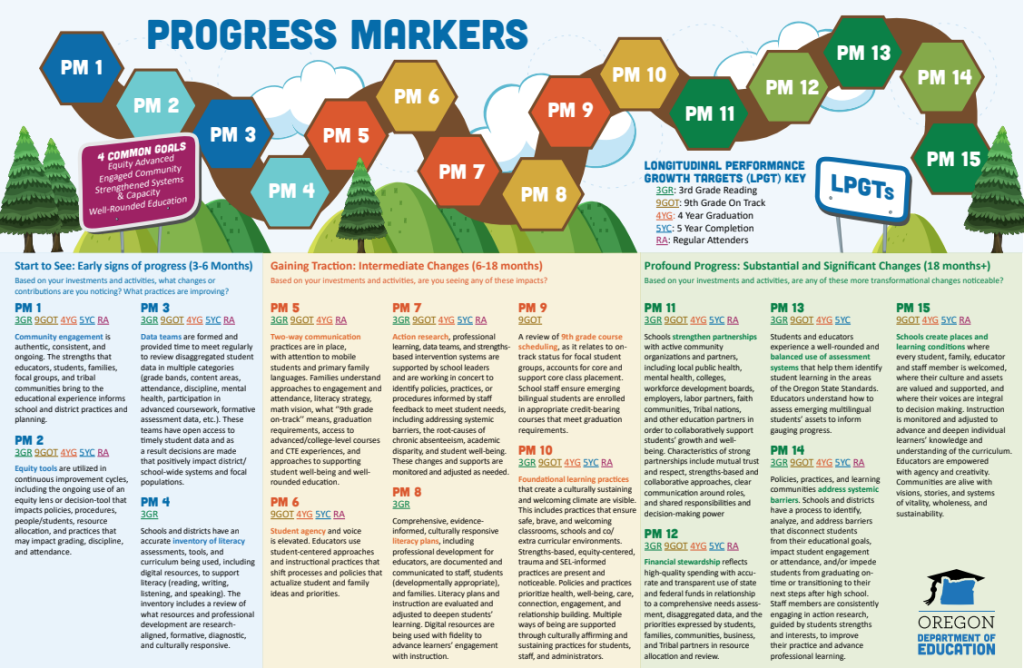
Resources
LGPD and LOM Webinar Series (April 2025)
Currently Available:
- What is LPGT Co-Development?
- Overview of the LPGT Co-Development Process
- Navigating Smartsheet for LPGT Co-Development
- Data Literacy for LPGT Co-Development
- Setting Baseline and Stretch Targets
- Setting Gap Closing Targets
- Local Optional Metrics
2023-2028 LPGTs and LOMs: Grantee Targets
Attendance
Attendance Works has shared resources to support districts in reducing the impact of lower attendance rates in the spring; also referred to as the Spring Attendance Slide.
Reminder: The 2024-25 ODE Professional Learning Opportunities website lists all professional development opportunities provided by ODE. Also the EII Technical Assistance, Professional Learning and Coaching calendar is now available to track EII specific TA, PL, and other coaching opportunities.
School District Literacy Grant Resources
In 2023, the Oregon Legislature established early literacy as a top priority. In creating the Early Literacy Success Initiative, they identified four goals:
- Increase early literacy for children from birth to third grade;
- Reduce literacy academic disparities for student groups that have historically experienced academic disparities;
- Increase support to parents and guardians to enable them to be partners in the development of their children’s literacy skills and knowledge; and
- Increase access to early literacy learning through support that is research-aligned, culturally-responsive, student-centered and family-centered.
These goals will be accomplished through four programs: the Early Literacy Success School District Grants, the Early Literacy Success Community Grants, Early Literacy Success Tribal Grants, and the Birth through Five Literacy Plan (administered through the Department of Early Learning and Care).
The Early Literacy Success Initiative secures $90 million in non-competitive, application-based grants for the biennium to support comprehensive early literacy plans (defined as pre-kindergarten through third grade) in order to increase early literacy statewide.
ODE Resources (these can be found on ODE’s Literacy landing page)
-
- The Guidance helps summarize the legislation and lays out how the grant program works, while providing clarity in what will be expected and reviewed.
- Grant application and reporting are fully incorporated into Integrated Guidance. There will not be a separate application.
- Requirements overview (NEW)
- Oregon’s Early Literacy Framework (pdf) provides the content to engage in deep learning and frame the big picture of effective early literacy. See also the Early Literacy Framework webpage with resources.
- Adolescent Literacy Framework (pdf) + webpage with resources
- The Program Review Tool guides applicants through applying the Framework to their given setting and includes eight questions that will be required in the Application.
- The Application Planning Template is a practical tool in which an applicant lays out what they will be required to submit alongside the Inventory and Budget.
- The Literacy Inventory and Budget includes the template for the inventory required by the legislation and provides pre-populated budget cells that help with planning for allowable expenses. This will be required as an attachment in the Application.
- High dosage tutor training criteria
- Extended learning criteria
- Supplemental materials
- Preschool curriculum guidance
- High Quality instructional materials – additional resources
- Allowable use guide
- The Guidance helps summarize the legislation and lays out how the grant program works, while providing clarity in what will be expected and reviewed.
FAQs
Click for a full list of ODE’s FAQs (25-27).
Hiring — You may use funds to hire literacy coaches, specialists, and interventionists if they meet all of these criteria:
- Must have specific advanced training in “research-aligned literacy strategies” and “the science of reading and writing” that is
- included in a course in an educator preparation program
- or included as a course in a post-graduate degree program in teaching reading or literacy
- or provided by ODE or included on the ODE list of PD providers
- or provided by a school district or ESD
- Must have a literacy-focused licensure endorsement
- Primary role and responsibility must be direct support of students and/or educators
Purchasing Curriculum — Core curriculum must be purchased from the ODE-approved list. Supplemental material purchasing guidance is not yet available.
Requirements for Literacy Coaches, Specialists, Interventionists — Starting in 2025, do all literacy coaches, specialists, and interventionists funded by the grant have to have both:
- a literacy-focused endorsement
- in addition to the advanced training in “research-aligned literacy strategies” and “the science of reading and writing.”
ODE Answer: Yes. The training does not take place of the endorsement but is in addition to the endorsement.
What qualifies as “advanced training”? Is there a list of these trainings that would qualify as meeting this requirement or as long as they have taken a Science of Reading workshop offered by SOESD that would meet the requirement?
ODE Answer: Districts may meet the requirement for advanced training or certification in “research-aligned literacy strategies” and “the science of reading and writing,” through any of the following methods:
- Completing course(s) in an educator preparation program,
- Completing course(s) in a post-graduate degree program in teaching reading or literacy; or
- School districts or ESDs provide the advanced training.
Completing a Science of Reading workshop offered by SOESD would meet the requirement under the third bullet point. If using internal training, the individual school or ESD may determine the specific parameters around the amount of training required.
What endorsements meet the grant requirements for being a literacy coach, literacy specialist, or literacy/reading interventionist?
ODE Answer: Beginning in the 25-27 biennium, literacy coaches, specialists or interventionists* must (among other requirements) hold one of the following endorsements in order to to be funded through Early Literacy dollars:
- Elementary Multiple Subject
- Reading Intervention
- Special Education: Generalist
- English to Speakers of Other Languages (ESOL)
*Interventionists must hold a Reading Intervention Endorsement
Other questions? ODE can be reached at k12.literacy@ode.oregon.gov.
This section is under construction. Please check back for updates later.
Background
In 2021, the Oregon Legislature passed Senate Bill 732 amending Oregon Revised Statutes (ORS) 328.542 and 329.095. Each school district will be required to establish what the law calls an Educational Equity Advisory Committee, which ODE will refer to as a District Equity Committee (DEI Committee). Committees will be required for districts with >10,000 students effective Sept. 15, 2025. More detail below.
Senate Bill 732 requires establishment of an educational equity advisory committee in each school district to advise school district board and superintendent about the educational equity impacts of policy decisions and to inform district leaders when situations arise that negatively impact underrepresented students.
n 2021, the Oregon Legislature passed Senate Bill 732 (ORS 329.711) and amended Oregon Revised Statutes 328.542 and 329.095. SB 732 requires each school district to establish what in statute is described as an ‘’educational education advisory committee’’ and for this guidance will be referred to as a District Equity Committee (DEC).
ODE released new guidance to support implementation of SB 732. District Equity Committees are meant to help school leaders identify what helps or hinders the success of students who Oregon’s educational systems have historically excluded, impacted, marginalized, or underserved. They are intended to advise school boards and superintendents on the educational impacts of policy decisions, the larger district-wide climate, issues impacting underserved student groups, and additional topics necessary to fully elevate student experience and community voice.
This bill and guidance have benefited from efforts, inputs and partnership with statewide equity leaders, rural school leaders, COSA, OSBA, and the Oregon State Board of Education.
Questions or requests for support on implementation can be directed to tanya.frisendahl@soesd.k12.or.us or ODE.EII@ode.oregon.gov.
House Bill 2281 (HB2281)
In 2023, the Oregon Legislature passed House Bill 2281. The bill requires that school districts and public charter schools designate a civil rights coordinator to provide guidance and respond to questions and complaints relating to discrimination. Districts will be required to have a designated compliance officer by January 1, 2024. More detail to come.
Training for Civil Rights Coordinators
2024-2025 Training
- In-person training was held August 6-7, 2024 in Salem, Oregon and is complete for this year. Additional in–person training options will be held in future years.
- Virtual synchronous training will be conducted via 2 hour Zoom sessions held twice a month from October 2024-March 2025 (Thursdays, 9-11 am).
- Virtual asynchronous training is available via Canvas course.
What activities can be funded by SIA funds?
- Expand Instructional Time
- More hours or days
- Summer programs
- Before/after-school programs
- Address Student Health and Safety
- Social emotional learning, trauma informed practices
- Mental and behavioral health
- More school health professionals
- Facility improvements
- Reduce class size and caseloads
- Provide a well-rounded education
- Early literacy
- Middle school programs and supports
- Broadening curricular options (art, music, PE, STEM, CTE, engaging electives, college credit opportunities, dropout prevention, life skills classes, talented and gifted programs, and access to licensed librarians
Plan Adjustments vs. Plan Amendments: What’s the difference?
Adjustment: For minor changes to your SIA plan that align to current strategies, help achieve named outcomes, as well as address needs identified through community engagement. Examples of a plan adjustment include the addition or removal of activities within an existing strategy that already exists within the current three-year plan.
Amendment: For making more structural changes to your SIA plan which may include the addition or removal of entire strategies or outcomes. This would also include if you are modifying your plan to address new needs identified through ongoing community engagement. Examples of a plan amendment include a changed relationship with a charter school in your district or as mentioned the permanent removal of a strategy in the original three-year plan. In addition, if ODE recommended that you update your strategy language during the progress report process, please file your plan update as an amendment, which means you’ll also be able to upload the new strategy language on either the Integrated Planning Tool or another format.
If you have additional questions you can email Tanya Frisendahl.
What are the expectations for maintaining SIA documents on our district or school website?
The Student Investment Account is rooted in community engagement and transparency. In keeping with this spirit, districts and eligible charter schools are required to post important documents including their SIA plan, budget, and grant agreement to their websites. The SIA team shares the following as guidelines for all SIA documents posted to recipient websites:
- Original plans and budgets (board approved) should be maintained on the district website. Once the original plan and budget is updated through adjustment or amendment in the spring, it should also be posted alongside the original plan and budget until the full application cycle is completed again in spring at the end of the biennium, and at that time, the new board approved plan and budget can replace the earlier versions on the district website.
- SIA grant agreements should also be maintained on the district website until the full application cycle is completed. If the grant agreement is amended, ODE encourages recipients to post it alongside the original grant agreement on the district website.
Some districts have a Student Success Act/Student Investment Account webpage that is dedicated to posting information about community engagement activities and events, the legislation and the documents referenced above. Other districts have a “Documents” link where these items can be found. While districts and eligible charter schools have discretion as to where they post these documents, they should be easily searchable and accessible (one to two clicks away from the main webpage).
Can we claim indirect?
Q: Our district’s indirect rate is less than 5% for other funding streams. Can we still claim up to 5% of SIA funds for administrative costs, which include indirect costs?
A: Yes, according to Oregon Administrative Rules for SIA funds, districts can charge up to 5% or $500,000, whichever is less, for administrative costs which include indirect costs regardless if their approved rate is lower for other funding streams.
Another question? ODE keeps a rolling list of FAQs and answers. Click here to view.
At-a-Glance School and District Profiles
Annual profiles have been released. They are available here: https://www.ode.state.or.us/data/reportcard/reports.aspx
2024 SIA Legislative Report
On February 1, 2024, OEII submitted the Student Investment Account Legislative Report to the 2024 Legislature. The Annual Report provides an update on SIA program implementation, investment of resources, and continued analysis of impact of investments. The report also details ongoing work to support alignment of programs under the Integrated Guidance.
The 2025 report is not yet available.
